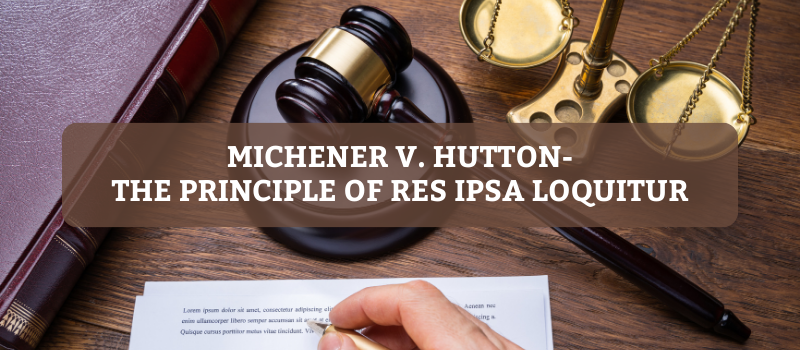In Michener v. Hutton, the plaintiff invoked the legal doctrine of res ipsa loquitur due to the unexplained fall of a vent pipe. Res ipsa loquitur, which literally translates to “the thing speaks for itself,” is a powerful legal principle that has been successfully applied in a variety of circumstances, including claims against carriers for harm to passengers, incidents involving falling objects, and situations where harm is caused by objects under the defendant’s control.
To receive compensation in a negligence case, the plaintiff must establish beyond a reasonable doubt that the defendant’s carelessness was the direct cause of their injuries. The onus of proof transfers to the defendant when res ipsa loquitur is present. They must offer proof that refutes the plaintiff’s initial claims and establishes their lack of negligence by allowing plaintiffs to establish a prima facie case of negligence based only on the accident’s circumstances.
Background of the case:
The plaintiff, in this case, sustained bodily injuries on September 28, 1922, while working as a carpenter on a construction site in Los Angeles. Hutton, the plumbing contractor, and Goekler, an employee of Hutton, were defendants who worked on the building project. The plaintiff alleged that the defendant’s negligence caused his injury.
A vent pipe from the building’s second story to the roof had been erected by Goekler the day before the disaster. The connections used to unite each part of the pipe were filled with oakum or hemp and then sealed with molten lead. Goekler said that he had intended to return later to caulk the topmost joint with lead, but had failed. The upper length of the vent pipe dropped the following day when the plaintiff was working on the first floor, striking him in the shoulder.
The plaintiff appealed a judgment rendered following a jury decision that awarded damages for personal injuries allegedly caused by the defendant’s carelessness. The use of res ipsa loquitur in the case was disputed by the defendants, the plumbing contractor, and his employee who was in charge of fitting the pipe.
Understanding Res Ipsa Loquitur:
Res ipsa loquitur is a legal doctrine that permits the conclusion of carelessness from the circumstances and character of an event. The theory is applicable when it seems from the accident itself that it would not have happened if reasonable care had been used. When the defendant or their workers had control over the thing or circumstance that produced harm, it offers reasonable proof of carelessness.
The plaintiff cited the res ipsa loquitur doctrine in light of the accident’s circumstances. When three requirements are satisfied, the doctrine permits the inference of negligence:
(1) the event giving rise to the harm was within the defendant’s control;
(2) the accident was one that wouldn’t ordinarily occur if reasonable care were used; and
(3) there was no other reasonable explanation for the incident.
Application of Res Ipsa Loquitur:
According to the plaintiff, the falling vent pipe satisfies all requirements for applying the res ipsa loquitur doctrine. Goekler was in charge of installing the pipe and still needed to finish the sealing, thus it was obvious that the defendants were in charge of it. Furthermore, unless negligence was involved, it was uncommon for a properly installed pipe to fall
Due to the vent pipe’s unexplained fall, the plaintiff in the current instance claimed res ipsa loquitur. The theory has been successfully used in a variety of situations, including lawsuits against carriers for harm to passengers, incidents involving falling objects, and situations when harm is caused by objects in the defendant’s control.
The defendants disputed the doctrine of res ipsaloquitur’s applicability in this instance, asserting that it should not. Apart from the use of the concept, they said that the evidence was insufficient to substantiate the plaintiff’s claim. But the plaintiff insisted that given the circumstances, res ipsa loquitur was especially pertinent.
The onus of Proof:
The plaintiff must prove beyond a reasonable doubt that the defendant’s negligence led to their injuries in order to be awarded damages in a negligence claim. However, the onus of proof transfers to the defendant when res ipsa loquitur is present. They must offer proof to refute the plaintiff’s initial assertions and show their lack of negligence.
When res ipsa loquitur is present, the onus of proof shifts to the defendant in order to disprove the implication of carelessness. The plaintiff’s initial case must be refuted by the defendant with evidence. However, it is still the plaintiff’s responsibility to prove negligence through a preponderance of the evidence.
Role of the Jury:
The jury’s task is to decide whether the defendant successfully refutes the inference of carelessness brought about by res ipsa loquitur. The evidence offered by the defendant in support of their defense must be weighed by the jury against the inference of negligence. The presumption itself is evidence that the jury must take into account when rendering a decision.
As a result of the circumstances surrounding an accident, plaintiffs may prove a prima facie case of negligence under the persuasive legal notion known as res ipsa loquitur. The theory was crucial to the jury’s decision and subsequent appeal in the case under discussion. Both plaintiffs and defendants in personal injury claims when the accident speaks for itself must be aware of the concepts and uses of res ipsa loquitur.
In situations where an accident speaks for itself, the res ipsa loquitur doctrine is a useful tool. When specific requirements are met, it permits an inference of carelessness, shifting the burden of proof to the defendant. In this case, the use of res ipsa loquitur was crucial in establishing culpability and in the subsequent granting of damages to the plaintiff.

